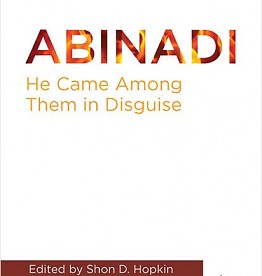 Review
Review
Title: Abinadi: He Came Among Them in Disguise
Editor: Shon D. Hopkin
Publisher: The Religious Studies Center, Brigham Young University; Deseret Book
Genre: Interdisciplinary Scholarship
Year Published: 2018
Number of Pages: 380
Binding: Hardback
ISBN10: 1944394265
ISBN13: 978-1944394264
Price: $27.99
Reviewed by Carl J. Cranney for the Association for Mormon Letters
Abinadi: He Came Among Them in Disguise is the first offering from the newly established Book of Mormon Academy at Brigham Young University. If this inaugural volume is any indication, we can expect much good scholarship from this group in the future. “Abinadi” is a fantastic read, showing how different scholars from different fields can bring their expertise to study scripture. The field of Book of Mormon studies is not new, but has been seeing a bit of a renaissance the past few years. This collection marks a new and welcome advance to the field, along the lines of the Mormon Theology Seminar’s work, but perhaps a touch more rigorous and diverse. It is also wonderful to see such a scholarly work published jointly between BYU and Deseret Book.
The book is divided into four sections: literary, intertextual, cultural-historical, and theological studies. Those broad categories are used to organize the essays themselves, which vary in their approach and their theses. I felt there was some minor overlap among the essays in the literary section, but aside from this small observation about those particular chapters in the book, the reader will be pleasantly surprised at the range of topics as well as the depth probed on each of those topics.
Only one essay felt disappointing, Kerry Hull’s “An ‘East Wind’: Old and New World Perspectives,” found in the cultural historical section. This one essay spent a great deal of time discussing varying takes on east winds as harbingers of destruction both in Near Eastern and Mesoamerican contexts, only to spend a single page on the Abinadi story with an unsatisfying thesis that “a reference to an ‘east wind’ could be plausible in this context, but we can’t really know.” It is the weakest of the essays regarding actual discussion of the Abinadi story, but the breadth of the discussion of the idiom of “east winds” in many cultural contexts is thorough and meticulous.
Of particular note, to me, were the essays by Mark Wright with Hull and Amy Easton-Flake. Wright and Hull give a harrowing discussion of the Native American practice of “scourging with faggots,” beating captives to death with burning sticks—a process that could last days. That this seems to most accurately describe Abinadi’s method of execution gives insight into the motivations and courage of Abinadi. Also, it helps make sense of his very long-winded final testimony and cursing of King Noah and his priests while the execution was being carried out, a point that had never quite made sense to me if the standard interpretation of Abinadi’s being burned alive held true.
Easton-Flake’s article on infant salvation in 19th-century American theology and the Book of Mormon highlights the array of discussions among Presbyterians, Methodists, Baptists, and others, and compares those discussions to the theology presented in the Book of Mormon by Abinadi, King Benjamin, and Mormon. Her insightful analysis shows that the Book of Mormon, far from merely aping a pre-existing set of principles on the subject, manages to touch on the thinking from many demoninations while also forging a uniquely Christocentric doctrine of infant salvation. Her work shows how the Book of Mormon can seem unremarkable at first glance, but a deeper dive into its text shows great complexity and nuance.
Indeed, that might be the best takeaway from the entire set of essays. I have highlighted ones I thought were the most personally insightful, but a different reader might have picked an entirely different set to discuss.
I found all of the essays gave new light to the Abinadi story, and taken together, both provide much insight into this particular portion of the Book of Mormon text as well as demonstrating that a closer look at the Book of Mormon can bear fruit in many different scholarly fields.
This inaugural volume from the Book of Mormon Academy portends many great things to come in the field of Book of Mormon Studies as the Academy continues its work.
